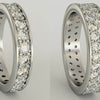
Fake Diamonds vs. Natural Diamonds: Understanding the Difference
Table Of Contents
Introduction
Jewelry is a powerful symbol of commitment, love, and wealth. Whether you're a wedding planner eyeing the perfect ring for that dream proposal or an anniversary enthusiast scouting for the perfect gift, it's crucial to understand the distinction between synthetic diamonds vs natural diamonds. This will not only save you from potential pitfalls but also ensure that you get the best value for your money.
Natural Diamonds

Natural diamonds have been at the heart of some of history's most iconic love stories. Born deep within the Earth's mantle, these gemstones are formed under intense heat and pressure over millions of years. Their sparkle, resilience, and uniqueness are unmatched. Every natural diamond has its story, from its journey from the depths of the Earth to the hands of skilled artisans who shape and polish them into dazzling pieces of art.
Pros of Natural Diamonds:
Uniqueness: Every natural diamond has its own distinct characteristics.
Symbolism: Represents an everlasting bond and enduring love.
Resilience: Among the hardest substances on Earth.
Cons of Natural Diamonds:
Price: Typically more expensive due to mining and processing costs.
Environmental Concerns: Mining can sometimes lead to ecological disruptions.
Fake Diamonds: Simulants and Synthetic Diamonds

Here, we delve into the world of fake diamonds. Not all "fakes" are equal. Some are mere imitations, while others are real diamonds, albeit man-made. Let's dive in.
Simulants:
A diamond simulant is a stone that looks like a diamond but has a completely different chemical structure. Cubic zirconia (CZ) and moissanite are the most common diamond simulants. They offer the bling at a fraction of the price, making the debate between simulated diamonds vs real diamonds particularly attractive for budget-conscious shoppers.
Pros of Diamond Simulants:
Affordability: Much cheaper than both natural and synthetic diamonds.
Look: To an untrained eye, they can appear very similar to real diamonds.
Cons of Diamond Simulants:
Durability: Simulants are typically softer and prone to scratches.
Sparkle: While they shine, they lack the depth and fire of real diamonds.
Synthetic Diamonds:
Synthetic diamonds, or lab-grown diamonds, are not simulants. They share the same physical and chemical properties as natural diamonds. The only difference? Their place of origin. These diamonds are grown in controlled environments using advanced technological processes.
Pros of Synthetic Diamonds:
Price: Generally less expensive than their natural counterparts.
Ethical Production: No mining means no environmental degradation or ethical dilemmas.
Quality: Often more flawless than natural diamonds as they're grown in controlled settings.
Cons of Synthetic Diamonds:
Perception: Some people feel synthetic diamonds lack the romantic appeal of natural diamonds.
Visual Differences
At first glance, distinguishing between fake and natural diamonds can be a Herculean task. They both shimmer, they both dazzle, and they both have that heart-stopping beauty that can leave anyone speechless. But look a little closer, and the subtle differences begin to emerge.
- Luster and Fire:
Natural diamonds have an unmistakable luster and fire (the play of colors you see when light is dispersed). Synthetic diamonds, on the other hand, often have a slightly different fire pattern. It might be too uniform or just a tad off when compared side by side with a natural stone.
- Inclusions:
Perfect diamonds are incredibly rare. Most natural diamonds have tiny imperfections or inclusions. Many synthetic diamonds are almost too perfect, which can be a giveaway. However, it's worth noting that advanced techniques now introduce imperfections in fake diamonds to mimic the real ones.
- The Setting:
Often, high-quality natural diamonds are set in equally high-quality metals. If you see a stone that looks like a diamond set in a cheaper metal, it might be a red flag. However, this isn't a sure-shot method as many opt to set synthetic diamonds in premium metals too.
Physical Properties and Tests
Going beyond the visual, understanding the difference between synthetic diamonds vs real ones requires a deeper dive into their physical properties. Let's embark on this scientific adventure, shall we?
- Hardness:
Natural diamonds are the hardest known substances on Earth, ranking a solid 10 on the Mohs scale. Most fake diamonds don't match up in hardness, but here's the twist: some high-quality synthetic diamonds do! So, the scratch test isn't always foolproof.
- Heat Conductivity:
Natural diamonds are excellent heat conductors. If you breathe on a real diamond, the fog will dissipate almost immediately. Synthetic diamonds, especially those made of materials like cubic zirconia, retain the heat and stay foggy longer. But again, high-end synthetic diamonds might pass this test.
- The Water Test:
Due to their density, real diamonds will sink in water. Many fake diamonds will float or sink slowly. But remember, weight and mounting can affect this test.
- The Read-Through Test:
When you turn a real, loose diamond upside down and try to read through it, it becomes nearly impossible due to its high refractive index. Most fake diamonds won't offer the same level of distortion.
- Professional Testing:
When in doubt, the best way to differentiate between synthetic diamonds vs real is by seeking a professional's help. Advanced machines and expertise can quickly and accurately tell the difference.
Certification and Grading
One of the first steps in distinguishing between fake and natural diamonds is understanding certification and grading.
Natural Diamonds: When it comes to natural diamonds, certification is a must. Renowned gemological institutions, such as the GIA or AGS, assess and grade diamonds based on their color, clarity, cut, and carat weight. When purchasing a natural diamond, always ask for its certification. It’s a guarantee of the stone’s authenticity and quality.
Man-Made Diamonds: Contrary to popular belief, man-made diamonds can also be certified and graded, much like their natural counterparts. Using similar criteria, institutions can provide insights into the stone's quality and attributes. However, it's essential to ensure the certificate clearly states the diamond's man-made origin.
But why is this certification so vital? Well, apart from ensuring you’re getting what you paid for, it helps in differentiating man made diamonds vs real diamonds, especially as technology has made the distinctions increasingly subtle.
Pricing and Value Considerations
Ah, the age-old question of value. When weighing the pros and cons of man made diamonds vs real diamonds, pricing plays a pivotal role.
Natural Diamonds: Due to their rarity and the extensive mining process involved, natural diamonds command a higher price. Each natural diamond is unique, with its own set of inclusions and characteristics, adding to its value. Historically, natural diamonds have shown appreciation in value, especially rare and high-quality stones.
Man-Made Diamonds: Produced in controlled environments using advanced technological processes, man-made diamonds typically cost less than natural ones. This doesn't mean they're "cheap." On the contrary, these diamonds are every bit as brilliant and durable. They simply lack the natural origin story and rarity, which influences their pricing.
When considering an investment, natural diamonds hold a certain allure and historical value appreciation. However, if budget constraints are a concern, man-made diamonds offer beauty and durability without the hefty price tag.
Conclusion
When considering synthetic diamonds vs natural diamonds or even simulated diamonds vs real diamonds, your choice will boil down to personal preferences, budget, and values. Natural diamonds offer timeless beauty and symbolism, synthetic diamonds provide a more ethical and often affordable alternative, while simulants offer beauty on a budget.
Whatever your choice, understanding the differences ensures you make an informed decision, so the symbol of love you choose stands the test of time.
FAQ: Fake Diamonds vs. Natural Diamonds: Understanding the Difference
- What's the key distinction between synthetic diamonds vs natural diamonds?
At its core, the difference lies in their origin. Natural diamonds are formed over millions of years deep within the Earth's mantle under extreme pressure and temperature. In contrast, synthetic diamonds, also known as lab-grown diamonds, are made by humans using advanced technological processes that replicate the natural conditions under which diamonds form.
- Are simulated diamonds the same as synthetic diamonds?
Not quite! Simulated diamonds, such as cubic zirconia or moissanite, mimic the appearance of a diamond but are composed of entirely different materials. While synthetic diamonds vs real diamonds are essentially made of the same carbon atoms, simulated diamonds are not.
- How do synthetic diamonds vs real diamonds compare in terms of quality?
In terms of physical, chemical, and optical properties, high-quality synthetic diamonds can be almost indistinguishable from natural diamonds. However, depending on the technology used, some lab-grown diamonds might have inclusions or imperfections unique to their production process.
- Can jewelers easily tell the difference between man made diamonds vs real diamonds?
Not always. To the naked eye, a well-made synthetic diamond can look identical to its natural counterpart. Specialized equipment and expertise are often required to differentiate between the two.
- Why might someone choose a synthetic diamond over a natural one?
There are various reasons. Some people appreciate the environmental and ethical benefits of choosing lab-grown diamonds. Others might be drawn to synthetic diamonds vs natural diamonds due to the potentially lower cost for similar quality. Personal preference and values play a big role.
- Are there any misconceptions about synthetic diamonds vs real diamonds?
Yes, a common misconception is that synthetic diamonds are 'fake'. While they are man-made, they possess the same physical, chemical, and optical characteristics as natural diamonds. They are just as real, but their origin is different.
- In the battle of simulated diamonds vs real diamonds, which shines brighter?
The brilliance of a diamond, whether simulated or real, depends on its cut, clarity, and other quality factors. While a well-cut natural diamond might shine brighter than a poor-quality simulated one, high-quality simulants like moissanite can come very close to the brilliance of real diamonds.
- Are synthetic diamonds vs real diamonds priced similarly?
Typically, synthetic diamonds tend to be more affordable than natural diamonds of similar size and quality. This is due to the reduced mining costs and more controlled production processes.
- In terms of longevity, how do man made diamonds vs real diamonds stack up?
Both synthetic and natural diamonds are incredibly durable and can last a lifetime with proper care. After all, diamond is the hardest known natural material on Earth!
- What should I keep in mind when deciding between synthetic diamonds vs natural diamonds for engagement rings or other jewelry?
Consider what matters most to you. If you value tradition, you might lean towards natural diamonds. However, if you're eco-conscious or looking for better value, synthetic diamonds might be your pick. Always research and ensure you're purchasing from reputable sources, regardless of your choice.
Leave a comment
Please note, comments must be approved before they are published.









